Best Time to Visit India
The best time to visit India is from December to February, with pleasant daytime warmth and cool evenings. On the other hand, the least favourable time is from March to May when temperatures soar, making it hot and uncomfortable for travel. The monsoon season from June to September can also be challenging, with heavy rains affecting travel plans.
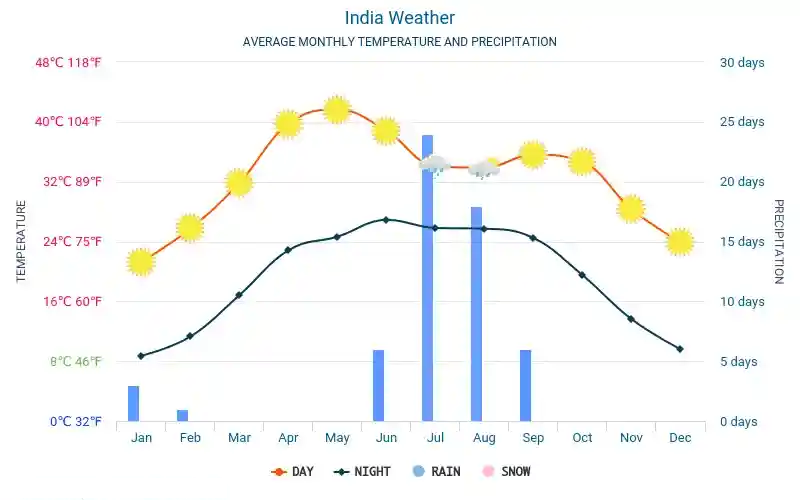
The Ideal Months for Optimal Weather Comfort
If you seek the most comfortable weather for your travels, look no further than the period spanning from December through February. During these months, you can relish the pleasure of clear skies and engage in a myriad of outdoor activities across the country. Moreover, this season proves to be exceptionally suitable for embarking on a tiger safari, as the reduced undergrowth and cooler temperatures result in heightened animal activity.
Optimal Timing for Mountain Hiking Adventures in India
For those passionate about mountain hiking, planning your excursions wisely can make all the difference. Ladakh proves to be an excellent destination between the months of June and August. Alternatively, consider embarking on a Himalayan trek during the periods from March to early June or from late September to November.
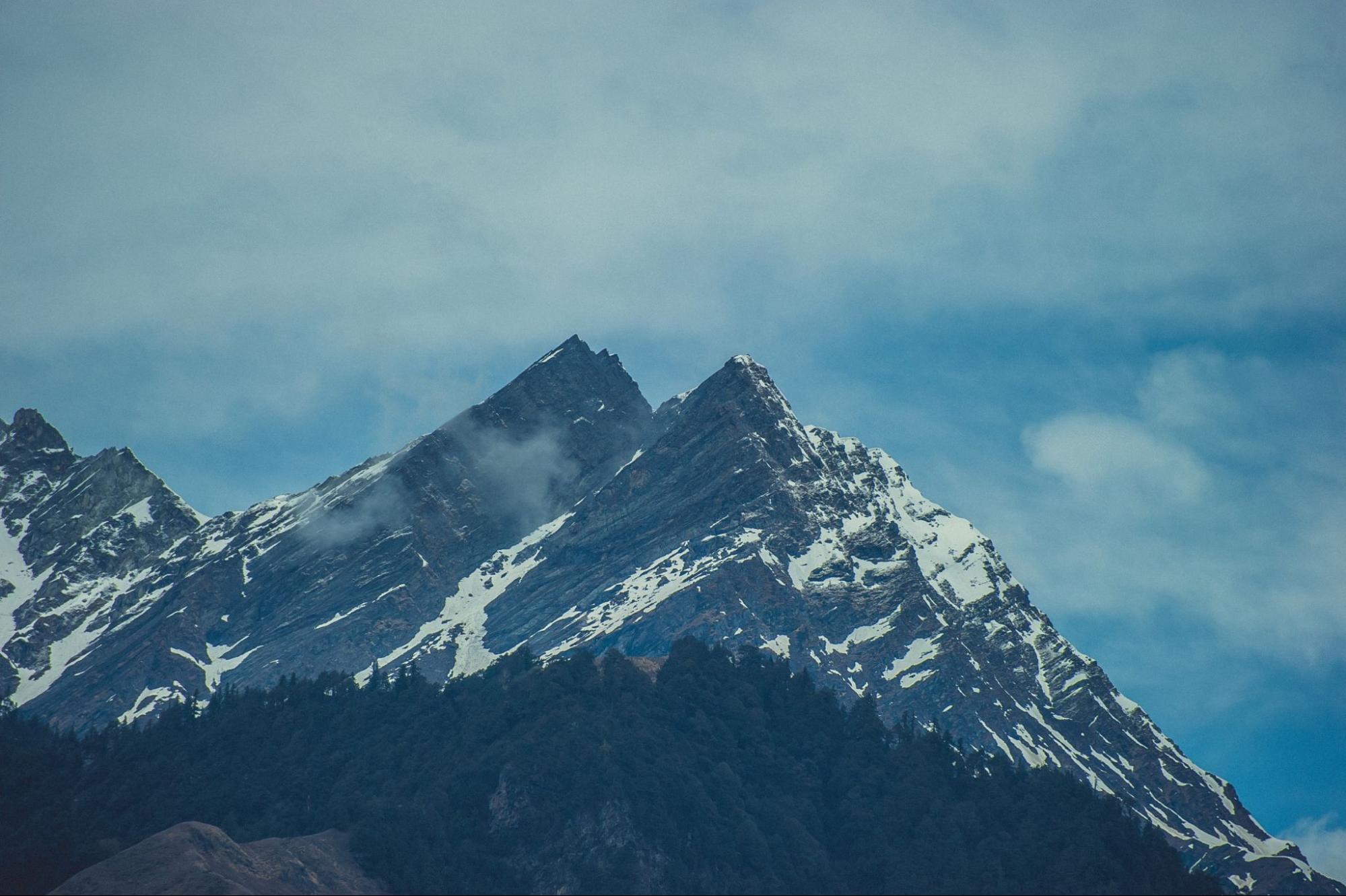
These timeframes promise a rewarding experience, characterised by cool weather and minimal rainfall. It's important to note that the Himalayan mountains receive copious amounts of rain from late June to early September, making this period less favourable for hiking enthusiasts.
Prime Opportunities for Festival Experiences
If you have a penchant for immersing yourself in India's vibrant festivals, Holi and Diwali are unquestionably among the most cherished celebrations. Holi typically graces the calendar in March, occasionally appearing in late February. In 2023, this jubilant festival falls on March 8th. Meanwhile, Diwali's festive splendour unfolds between the months of October and November, with the specific date being November 12th in 2023.
The Optimal Period for Cost-Conscious Travel in India
For travellers seeking the most budget-friendly options, the window between April and June presents the ideal opportunity. During this time, the sweltering heat dissuades many travellers, both domestic and international, from exploring India. Consequently, you'll encounter fewer crowds at popular temples, and you can anticipate significantly reduced prices, with many hotels and airlines offering discounts ranging from 30% to 50%.
Ideal Timing for Pleasant Weather and Cost Savings
For those seeking a harmonious blend of favourable weather conditions and cost-effective travel options, consider the months of March, October, and November as the golden middle ground. During these periods, you can avoid the sweltering heat experienced in April to June while benefiting from less congestion and more budget-friendly prices compared to the peak season spanning from December to February. These months offer a balanced and delightful travel experience.
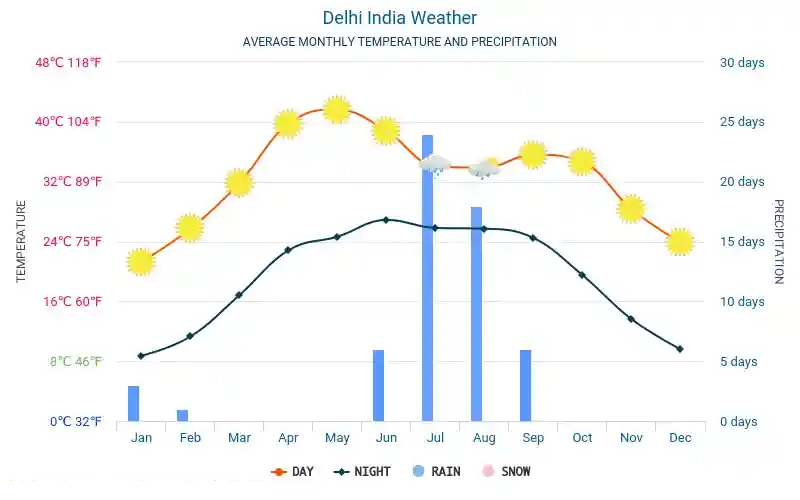
Optimal times to visit different places in India
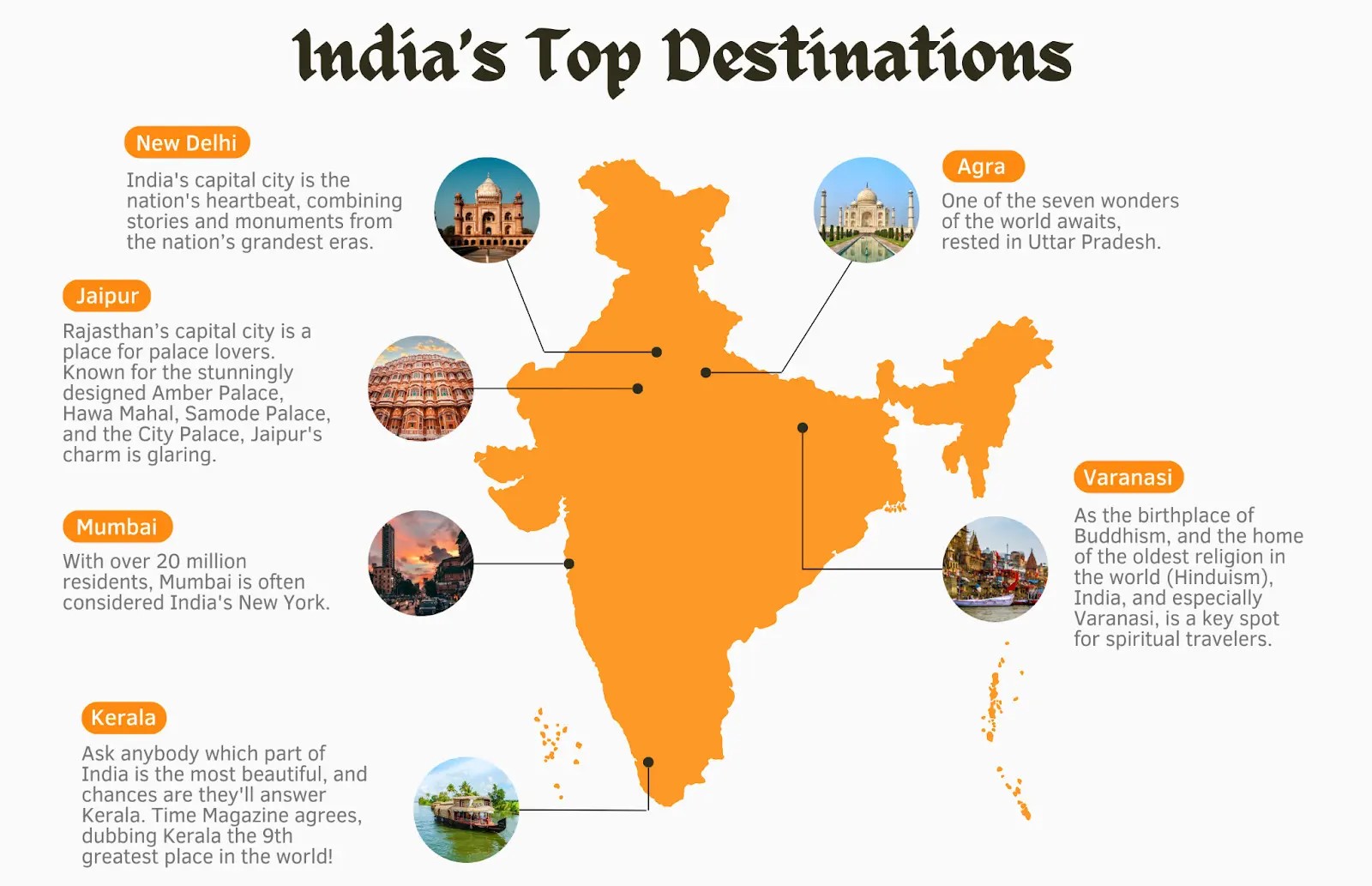
- Ideal Timing for a Delhi Visit
Delhi experiences a subtropical climate with distinct seasons. The best time to visit is from November to February to avoid monsoons and extreme summer heat, which is also suitable for Agra and the Taj Mahal.
- Optimal Timing for Exploring the Indian Himalaya
For exploring the Indian Himalayas, the best time is November to February for dry conditions, though it can be chilly in January and February. Avoid the monsoon impact in the eastern Himalayas, including Gangtok and Darjeeling, during the heavy rainfall period from June to August.
- Optimal Times for Visiting Goa
Plan your trip to Goa during the warm and dry months of January and February with pleasant temperatures. Avoid the monsoon season from late May to September and the hot and humid period in March, April, and November.
- The Prime Period for Exploring Kolkata
For a delightful visit to Kolkata, set your sights on the dry winter months, which span from mid-December to February. During this time, the weather is pleasant, with comfortable temperatures. As March approaches, the temperature begins to rise, and the heat can become quite intense. The monsoon season typically arrives towards the end of May, while October and November may bring an elevated risk of cyclones, tropical storms, and flooding.
- The Optimal Window for Discovering Mumbai
To experience Mumbai at its best, plan your trip for January and February, when the weather is dry yet not excessively hot. March, April, and May remain generally dry, though the heat can be overpowering. From June through September, Mumbai witnesses the heaviest monsoonal rains. Even in November and December, cyclones remain a possibility.
- Optimal Timing for Exploring Kerala
Kerala, adorned with its stunning backwaters, experiences distinct weather patterns. In Thiruvananthapuram, located at the southern tip of Kerala, the rainy season stretches from April to late November, characterised by milder yet more prolonged rainfall. The peak season in Kerala, ideal for travellers, spans from late November to late March. During this period, the weather is relatively dry and not excessively hot, making it the best time to explore the region.
- The Prime Period for Discovering Rajasthan
Rajasthan, encompassing renowned destinations like Jaipur and Ranthambore National Park, offers the most enjoyable experience during the months of December, January, and February. However, it's worth noting that Rajasthan remains a captivating destination throughout the year, as the impact of the monsoon is typically less pronounced compared to other regions.
The Optimal Window for Visiting Varanasi
Varanasi, an iconic spiritual hub, shines brightest from November to early March, before the onset of scorching heat. The months of April, May, and June bring extreme heat, while the monsoon season arrives in July, lasting until the end of September. For a more comfortable and enriching visit, targeting the period before the heat intensifies is highly recommended.
Month-by-month India travel guide
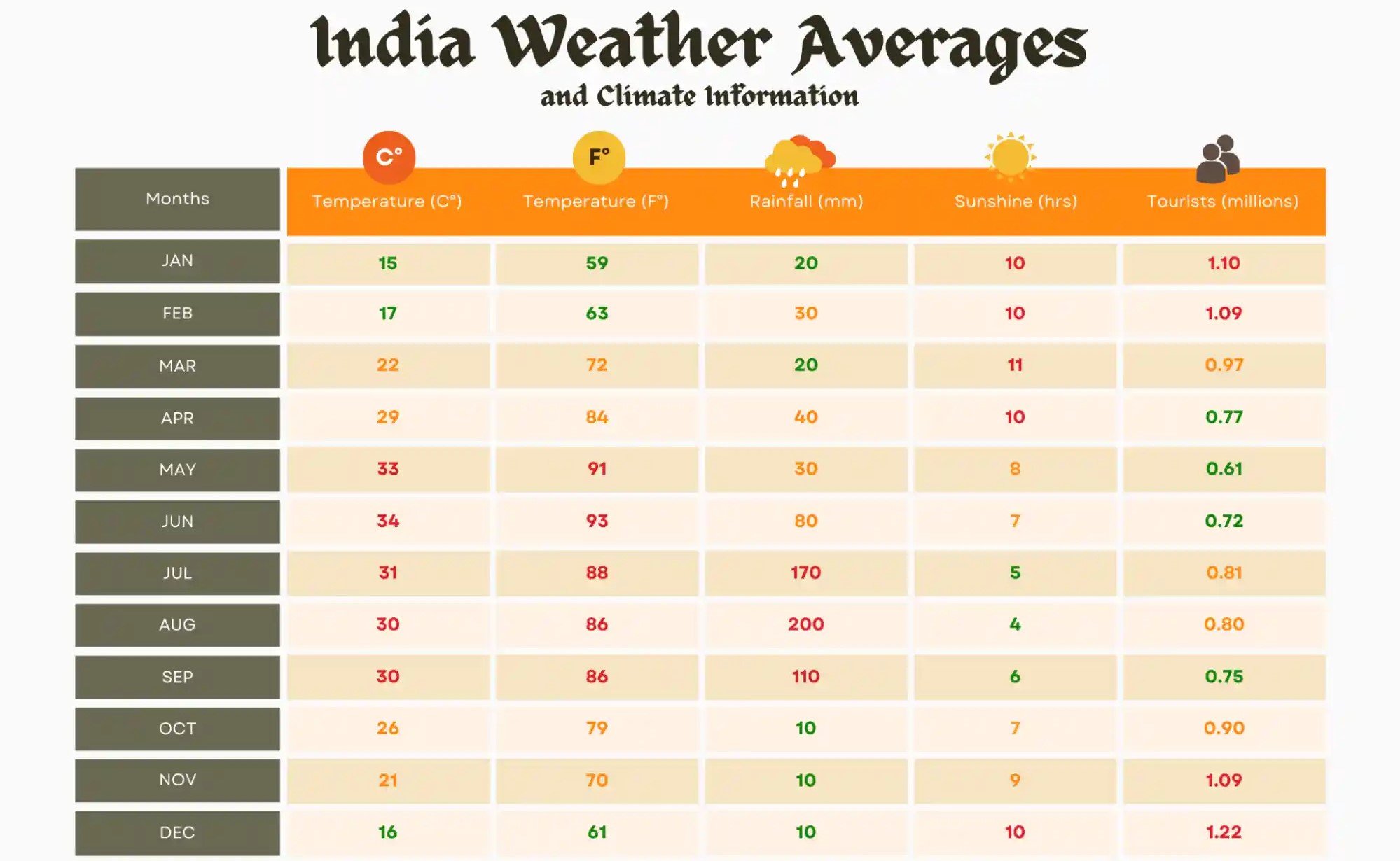
- January: Ideal for Varied Experiences
In January, India enjoys one of its driest periods, offering a diverse range of experiences. While the northern regions bring wintry enchantment, featuring snow-capped Himalayan foothills and opportunities to delve into Tibetan spirituality in Dharmsala or sip hot chai in Rishikesh's cosy cafes, the southern parts beckon with warmth. Goa's sun-kissed beaches provide a perfect getaway, while Kerala invites you to embark on houseboat cruises through its picturesque backwaters.
- February: Perfect for Royal Exploration and Cultural Revelry
February is an ideal time to explore Rajasthan, India, with rising temperatures and comfortable weather for visiting forts and palaces. The Thar Desert offers adventure opportunities, and you can catch the vibrant Jaisalmer Desert Festival celebrating Rajasthani culture.
- March: Ideal for Diverse Experiences
March is a great time to explore India's Golden Triangle, including the Taj Mahal and Amber Fort. The highlight is celebrating Holi, the festival of colours, with locals by tossing colourful powders. Holi typically falls on the last full moon in March.
- April: Perfect for Wildlife Encounters and Himalayan Hikes
As April arrives, India experiences increasing heat and humidity, with temperatures in cities like Delhi, Kolkata, and Chennai often soaring to 37°C/99°F. However, it's an excellent month for wildlife enthusiasts, particularly in Ranthambore National Park. The drier conditions lead animals to congregate around waterholes, offering a chance to spot majestic Bengal tigers. April also presents a picturesque time for hiking in the Himalaya, where vibrant wildflowers bloom.
- May: Ideal for Mountain Retreats
May in India can be hot and foggy, making mountain destinations like Darjeeling appealing for cooler weather. Towards the end of May, southern states welcome the monsoon rains, offering relief from humidity but often with intense downpours. Waterproof gear is advisable.
- June: Suitable for Northern Exploration and Fewer Crowds
June ushers in the wet season and oppressive humidity across India. Travel in southern India is limited due to heavy rainfall, making it an ideal time to explore the northern regions. Here, you can trade beaches and backwaters for mountain landscapes, river excursions, and yoga classes. While the heat can be challenging, June offers the advantage of fewer crowds and potentially lower prices.
- July: Discovering Rajasthan's Majesty sans Crowds
July sees saturation in the southern regions, leading to the closure of many national parks and an increased risk of landslides and flooding in lowland areas. However, Rajasthan's splendid forts and palaces in Jaipur, Jodhpur, and Jaisalmer remain accessible without the usual crowds. Alternatively, consider venturing into the Thar Desert, though it's important to note that temperatures may be high.
- August: Embracing Festivities and Unique Experiences
August in India brings heavy rains, but fewer tourists and potentially lower accommodation costs. The south's lush landscapes flourish, and Kerala's snake boat races and festivals like Independence Day and Ganesh Chaturthi provide unique experiences. It's also a good time for Golden Triangle exploration.
- September: Easing into Shoulder Season
In September, the rain begins to subside, marking a transition towards the shoulder season. It's an opportune time to visit popular sites in the Golden Triangle, as they are less crowded. Rajasthan exhibits its natural beauty, with lush countryside and full lakes courtesy of the monsoon rains. This month also coincides with one of India's significant harvest seasons, making it an ideal period to embark on a culinary adventure and savour the best of Indian cuisine.
- October: Ideal for Cycling Adventures and Diwali Celebrations
Pleasant weather prevails across most of India in October, making it an excellent time for leisurely cycling adventures. Additionally, Diwali, often referred to as the Festival of Lights, is celebrated during this month (although it may occasionally fall in November). During Diwali, expect to witness homes and streets adorned with dazzling lights, engaging candlelit ceremonies, and spectacular firework displays.
- November: Perfect for Pleasant Weather and Cultural Festivities
November welcomes cool and dry weather to many parts of India, reinvigorating a wide range of activities. Notably, the Pushkar Camel Fair becomes a major draw, where thousands of camels, adorned villagers, and entertainers gather in the holy city of Pushkar. This event showcases the unique customs and traditions, including the much-anticipated moustache competition.
- December: Ideal for Beach Getaways and Serene Retreats
December presents a varied climate in India, ranging from cold conditions in the north to clear skies and ample sunshine in the south. It's a busy month, with international travellers flocking to destinations like Goa for the festive season. For those seeking a quieter experience, the northern regions offer serene mornings along the misty Ganges in Varanasi or culinary explorations in Jaipur, complete with a Pink City Rickshaw tour.
Least favourable times to visit India
In essence, there is no inherently bad time to visit India. Regardless of the month you choose for travel, India offers a variety of experiences that are relatively unaffected by unfavourable weather conditions.
Inadvisable Times to Visit Popular Indian Cities
First-time travellers to India often visit iconic destinations like Delhi, Agra, Jaipur, Varanasi (in the north) or Mumbai, Goa, and Kerala (in the south). Extending the trip may include desert cities like Jodhpur, Udaipur, and Jaisalmer in Rajasthan.
Here are some important considerations for these areas:
- Avoid the Scorching Heat: If you cannot endure extreme heat, it's best to steer clear of the period from April to June. These months are known for their intense and sweltering weather conditions.
- Evade Heavy Rainfall: If you're not a fan of heavy rain, August should be avoided. India experiences its monsoon season from June to September, with August being the wettest month. However, during the rest of the monsoon season, you may still find opportunities for sightseeing, as the rainfall may not persist for extended periods.
- Desert Adventures: If your desire is to experience a desert camp in the western desert of Rajasthan, it's advisable to skip May and June. Some desert resorts may close due to the scorching heat during these months. However, accommodations in city areas remain viable. The desert, surprisingly, can be a great destination during the rainy season as it's minimally affected.
- Beach Retreat in Goa: If you're planning to relax on the beaches of Goa, it's wise to avoid the months of June to August. During this time, the summer's strong sea currents make swimming unsafe, and many resorts may temporarily close their doors.
Inadvisable Times to Explore Far North Mountain Regions in India
Embarking on a road trip to Ladakh, a destination renowned for its captivating mountain vistas and rich Buddhist culture, is a choice often made by those visiting India for the second time or those fortunate enough to have an extended vacation for their initial journey.
When considering these areas:
- Mountain Scenery and Buddhist Culture in Ladakh
If your goal is to immerse yourself in the awe-inspiring mountain scenery and delve into the enchanting world of Buddhist culture in Ladakh, it's prudent to steer clear of the period spanning from September to April. During this time, the mountain passes and roads become impassable due to heavy snowfall.
- Hiking in Himalayan Mountain Areas
For enthusiasts of hiking in the Himalayan mountain regions, it's best to avoid the late June to September timeframe when the region experiences extremely heavy rainfall. Additionally, December to January should be avoided, as routes become obstructed by snow during these winter months.